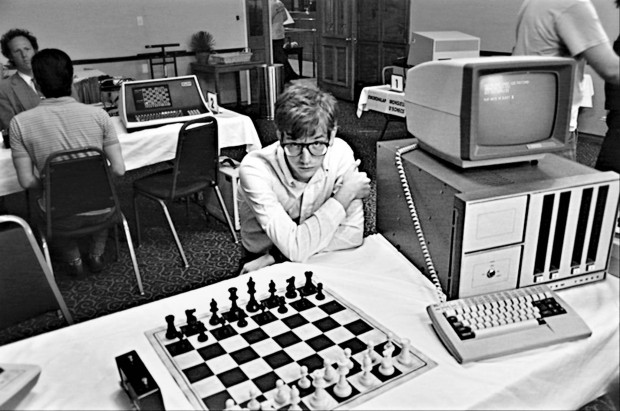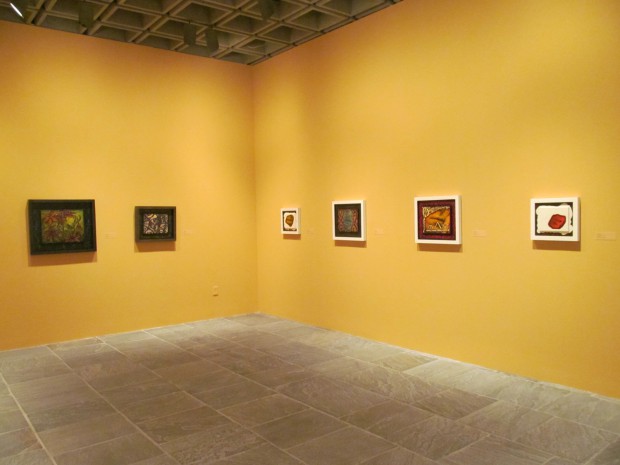Just like a reality TV show, the premise behind this year’s Whitney Biennial aims for high spectacle: What happens when you take three curators and ask them to put on three separate exhibitions at one of the world’s most prestigious museums? The world watches on, and we wonder what could possibly go wrong.
Plenty could fail, but it didn’t; this year we got a fairly traditional Biennial, full of good-looking, although not entirely memorable work. That seems to be a fairly standard line for most any Biennial over the last decade, where artists “working in many mediums present different and contrasting wares,” with emergent themes being “subtle rather than revelatory” and the political art “usually as subtle as a hammer.” (This all comes from Mark Stevens’s review of the 2004 Biennial, although it could just as easily been written about this one.)
With this year’s iteration, what we do have is a bunch of art that looks contemporary art without sharing much in the way of formal or conceptual concerns. Large, colorful works like Sterling Ruby’s smashed up ceramics would feel at home in exhibitions at any major museum. Kevin Beasley’s Nike Air Jordans with a purple geode growing out of them seem like a flip ironic reference to who knows what. There’s an eye-catching series of towering wall-reliefs by the late artist Terry Adkins, all made out of stacked drum cymbals. All three works are on three separate floors, but most viewers aren’t going to recognize the curatorial differences from floor-to-floor (although Michelle Grabner’s fourth floor does contain some of the exhibition’s largest work).
All this sameness-within-difference just reiterates that there’s no such thing as consensus in current art practice. So why showcase all these hundreds of works together, as if bigger were better? I’m sure we could make do with a much smaller, more concentrated Biennial. After so many years of same old thing, and the same type of critical response, it seems Howard Halle’s suggestion that an overhaul of the Whitney Biennial would be necessary (albeit unlikely). Its format is in crisis.
This year, nobody’s attempting to overhaul the Biennial format, but there are a substantial number of artists who have refused one “rule” of the Whitney game—that it showcase the state of contemporary art over the last two years. Several artists chose to curate the works of others, many whom are no longer with us. Count among these offerings Joseph Grigley’s “The Gregory Battcock Archive” (2009-14) a selection of personal ephemera from the late art historian and critic; Julie Ault’s selection of works by the late-artist Martin Wong and her screening of filmmaker James Benning’s Easy Rider (1969); and the late Tony Greene’s paintings curated by Catherine Opie and Richard Hawkins. Offsite, Tony Tasset’s “Artists Monument,” a primary-colored Plexiglas cube listing the names of nearly 400,000 artists—many, of course, who drifted into obscurity—evokes this sense of needing to shore up the past. (This work, located off the Hudson River at 19th street, doesn’t have any marker to indicate what it is to visitors; at visiting, I noted many confused passersby.)
The premise behind all this mini-retrospectives might lead one to believe we don’t need to spend our time showcasing more new art when there’s still so much of the past to explore. After all, why should we expect museums to focus on the newest of the new when “contemporary art” is by now an historical category? Most of us know that what’s current isn’t the best way to gauge contemporary art’s worth (current does not equal currency), but the Biennial has not necessarily caught up with the times.
That’s got to be a tough fact for the Whitney Biennial to chew on, especially because museums now have more in the way of competition to showing contemporary art. Art fairs have become a nearly year-round marketplace offering a quick survey of what’s happening in contemporary art. I spotted a handful of Biennial artists at this year’s Armory Show: Lisa Anne Auerbach’s “Let the Dream Write Itself,” a knitted painting showcasing common astrology advice like “Pay attention to moments of high awakening” and “Your will recreates you” was at the Whitney, but a nearly identical painting was shown by her gallery. Similar Sterling Ruby and Channa Horowitz works were available for purchase at the Armory, too. Even the less well-known painter Keith Mayerson, whose dozens of salon-style hung paintings at the Whitney included a very melancholy portrait of Abraham Lincoln, was one I last spied at last year’s NADA Miami. I could go on with the list of crossovers, but given that so many of these works are currently in circulation at art fairs, it’s difficult to understand what makes the Biennial different or special.
One modest difference with this year’s Biennial, to be honest, is the non-New York edge to this year’s Biennial. Out of the 103 artists and collectives showing at the Whitney Biennial, 17 of them come from Chicago. That might not seem like a lot, but for those who aren’t currently living in Chicago, many continue to have strong ties to the city. Karl Haendel who showed hyperrealistic graphite drawings on the fourth floor is one such example; he’s taught at the School of the Art Institute of Chicago. Whitney Biennial curator Michelle Grabner teaches at the School Art Institute of Chicago and Anthony Elms, curator of the second floor, served as Assistant Director of Gallery 400 at the University of Illinois at Chicago for six years before taking on the role of Curator at the Institute for Contemporary Art at the University of Pennsylvania. Also, as an Art Institute graduate, I was happy to see the city’s art scene highlighted even just a tad; Molly Zuckerman-Hartung’s “Notley,” a sliced-up drop cloth stretched over a frame with the word “No” on it, is the type of rebellious anti-painting that we need to see more of to counteract our current fascination with say-nothing formalism.
All this was great, but I’d liked to have seen more—even an all not-in-New-York Whitney Biennial. Otherwise just a handful of artists gives the impression that they’re participating in the same exhibition- and art-fair economy as everyone else; they might not be.
Very likely the issues arising from the Biennial’s format are part of a much larger crisis in the art world. Throughout the show there are certainly hints of this. “How many of you feel secure in your jobs?” asked My Barbarian during their performance of “The Mother,” the troupe’s hour-long interpretation of the Bertolt Brecht play by the same name; like Brecht’s play, My Barbarian’s is set in pre-Soviet Russia where an uneducated working-class mother ends up becoming an integral part of the labor movement. Downstairs, the target is the art world. “We don’t have art movements any more, we have market movements,” cries artist and critic Walter Robinson in Pedro Velez’s Twitter-inspired posters. And yet, despite our currently shit art world, we continue to be complacent with the current way of doing things—just like the Biennial. The response is to hold on to what you’ve got, if we believe in the message scrawled on Laura Owens’s large, silly painting “As-yet-untitled” (2014). In it, a boy and his dog dangle from a rope, surrounded by the words “When you come to the end of your rope, make a knot, and hang on.”
If we’ve reached the end—with the relevancy of the current way of doing things with the Whitney Biennial or the art world—there doesn’t seem to be any solutions in sight. So why keep at it?

Patrick Riester as Peter Bishton in the movie Computer Chess, a film by Andrew Bujalski. Credit: Kino Lorber
One answer gets played out in Computer Chess (2013), a movie centered around programmers determined to make a computer that can best humans at the game. (It’s playing on the second floor of the Whitney.) Though it seems a strange inclusion at first, there’s plenty of similarities between any gung-ho artist and gung-ho programmer. In one scene, close to the 18-minute mark, one programmer gets asked a series of question by one drunken partygoer:
“You seem like you’re from Mars to me. How do you get to be you?”
“Well, it’s hard to sum up. For the most part, I’m doing what I love to do. But I’ve got the resources that I need. If I need hardware, if I need computational cycles, or whatever…”
“What are you doing with your life?”
“I’m developing a computer chess program.”
The partygoer presses him on, asking him if he has any grand plans to work with DARPA or any intelligence agencies. The implication being that there’s no practical use in leading a life of computer chess. But no, the programmer answers, he’s doing it because he loves it.
That’s the most honest answer one can give for why they’ve chosen a career as an artist, programmer, writer, farmer, accountant, or anything else. It’s almost quaint, and very art-for-art’s sake—except for one difference. This programmer is trying to change the game entirely. At this year’s Whitney Biennial nobody’s on the brink of rewriting the rulebook.




{ 1 comment }
When there is a confluence in perception, when the background dominates the details, it is an indication of a failure in coherency and relevance. This type of survey show is faltering in the vastly expanded parameters of the global art environment that has seen a re-focusing to such a wide angle view in the last fifteen to twenty years. The singular relevance and dominance of a New York, or even U.S.-centered art survey has far less credibility now. So such a show’s implied conceit of presenting the best, newest, most relevant, most advanced or most commercially trafficked work begs for the basic hostility encouraged by any latently competitive cultural event. The paradox is that the lesson of mass inferiority such shows teach to the millions of artists never included is now imposed on those who are included when the authority of their work is no longer perceived. And when the details come off as being blurry, the integrity of the whole is exposed as being deficient.
Comments on this entry are closed.